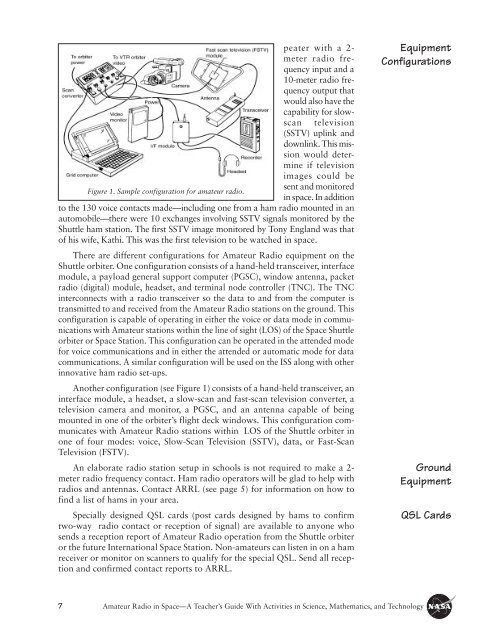Amateur Radio in Space - ER - NASA
Amateur Radio in Space - ER - NASA
Amateur Radio in Space - ER - NASA
- No tags were found...
Create successful ePaper yourself
Turn your PDF publications into a flip-book with our unique Google optimized e-Paper software.
Figure 1. Sample configuration for amateur radio.peater with a 2-meter radio frequency<strong>in</strong>put and a10-meter radio frequencyoutput thatwould also have thecapability for slowscantelevision(SSTV) upl<strong>in</strong>k anddownl<strong>in</strong>k. This missionwould determ<strong>in</strong>eif televisionimages could besent and monitored<strong>in</strong> space. In additionto the 130 voice contacts made—<strong>in</strong>clud<strong>in</strong>g one from a ham radio mounted <strong>in</strong> anautomobile—there were 10 exchanges <strong>in</strong>volv<strong>in</strong>g SSTV signals monitored by theShuttle ham station. The first SSTV image monitored by Tony England was thatof his wife, Kathi. This was the first television to be watched <strong>in</strong> space.There are different configurations for <strong>Amateur</strong> <strong>Radio</strong> equipment on theShuttle orbiter. One configuration consists of a hand-held transceiver, <strong>in</strong>terfacemodule, a payload general support computer (PGSC), w<strong>in</strong>dow antenna, packetradio (digital) module, headset, and term<strong>in</strong>al node controller (TNC). The TNC<strong>in</strong>terconnects with a radio transceiver so the data to and from the computer istransmitted to and received from the <strong>Amateur</strong> <strong>Radio</strong> stations on the ground. Thisconfiguration is capable of operat<strong>in</strong>g <strong>in</strong> either the voice or data mode <strong>in</strong> communicationswith <strong>Amateur</strong> stations with<strong>in</strong> the l<strong>in</strong>e of sight (LOS) of the <strong>Space</strong> Shuttleorbiter or <strong>Space</strong> Station. This configuration can be operated <strong>in</strong> the attended modefor voice communications and <strong>in</strong> either the attended or automatic mode for datacommunications. A similar configuration will be used on the ISS along with other<strong>in</strong>novative ham radio set-ups.Another configuration (see Figure 1) consists of a hand-held transceiver, an<strong>in</strong>terface module, a headset, a slow-scan and fast-scan television converter, atelevision camera and monitor, a PGSC, and an antenna capable of be<strong>in</strong>gmounted <strong>in</strong> one of the orbiter’s flight deck w<strong>in</strong>dows. This configuration communicateswith <strong>Amateur</strong> <strong>Radio</strong> stations with<strong>in</strong> LOS of the Shuttle orbiter <strong>in</strong>one of four modes: voice, Slow-Scan Television (SSTV), data, or Fast-ScanTelevision (FSTV).An elaborate radio station setup <strong>in</strong> schools is not required to make a 2-meter radio frequency contact. Ham radio operators will be glad to help withradios and antennas. Contact ARRL (see page 5) for <strong>in</strong>formation on how tof<strong>in</strong>d a list of hams <strong>in</strong> your area.Specially designed QSL cards (post cards designed by hams to confirmtwo-way radio contact or reception of signal) are available to anyone whosends a reception report of <strong>Amateur</strong> <strong>Radio</strong> operation from the Shuttle orbiteror the future International <strong>Space</strong> Station. Non-amateurs can listen <strong>in</strong> on a hamreceiver or monitor on scanners to qualify for the special QSL. Send all receptionand confirmed contact reports to ARRL.EquipmentConfigurationsGroundEquipmentQSL Cards7 <strong>Amateur</strong> <strong>Radio</strong> <strong>in</strong> <strong>Space</strong>—A Teacher’s Guide With Activities <strong>in</strong> Science, Mathematics, and Technology
















